Dean &
Ginny's excellent adventures... Main
Adventure Page
Grand
Voyage--2012:
<<
Part 1 <<
Part 2 <<
Part 3 <<
Part 4 <<
Part 5 <<
Part 6 <<
Part 7 <<
Part 8
Part
9 Part
10 >>
Part 11 >>
Part 12 >>
Part 13 >>
Part 14 >>
Part 15 >>
Part 16 >>
Part 17 >>
Part 18 >>
Part 19 >>
Part 20 >>
Part 21 >>
Part 22 >>
Part 23 >>
Part 24 >>
Part 25 >>
|
|

We loved the mountains behind Ushuaia and could see
some interesting-looking buildings from the ship. We were anxious
to get out and walk around even though the wind was strong.
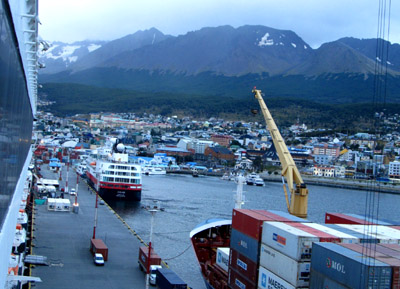

|

We could tell that we were in Argentina, because we saw
this sign (in Spanish and English) on the dock informing us
again that Great Britain and Northern Ireland have been
illegally occupying the Falkland Islands since 1833. A few days
later, we saw on CNN that Argentina has filed a formal complaint
to the United Nations. We'll stay tuned, as they say, with much
more first hand information... |
Because Ushuaia is the southernmost city in the
world, it's know as "fin del mundo" (the end of the
world).
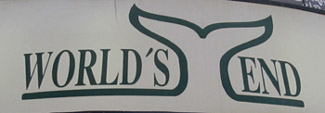

|
|

|

|
|

|
Many of the buildings appeared to be of
European design, even Hostel America (on left). The lace in many
of the windows added to this feeling.

|
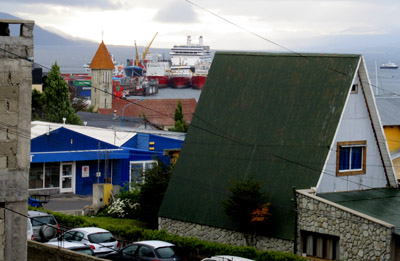 
Gardens graced some of the homes and parks in
the city.
|
|


 


We saw lots of these cool-looking birds with a loud squawk around the
city, especially in the parks. While we had no idea what they were, they
sort of acted like killdeer or plovers, so when we got back to the ship
we looked them up in the South American bird books in the library and
determined that they were southern lapwings in the plover family.
|
|


The street art was interesting. We especially liked the portrait of
a man made from drawings of trees and rocks--too bad that others
have overwritten it with graffiti.
|
|


The mountains are not just behind the city, but
were in evidence in every direction. Beautiful.
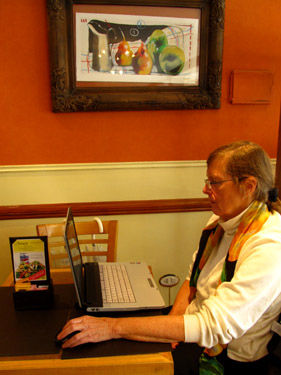
Later in the afternoon, when the weather was a
little better, we brought our computers ashore. We
bought some coffee, tea and croissants in a coffee shop in exchange
for some free Internet access. Good to be in touch and upload
some more of these trek pages. >>
Our next stop was Punta Arenas, Chile, a slightly
larger city that was, at one time, THE stop over spot for ships sailing around
Cape Horn. Once the Panama Canal was dug, it became less important,
but many ships still stop here to restock and refuel. The ship
anchored and we had to ride tenders ashore. We were scheduled for a
tour to Otway Bay to see penguins.
|
|

On the way to the penguins, the bus paused at a
llama and sheep farm with a classic auto museum. An unidentified car
is displayed on a blue tower.
|
|
|
 


|

These are Magellanic penguins like the ones we saw
in the Falkland Islands, but there are many more of them here. We
had a wonderful time walking around in our designated paths. The
penguins could walk anywhere...


Dean learns to walk like a penguin.





Beak clacking starts out as a twosome, but
escalates into a trio of activity. Not sure what the significance
is. These penguins mate for life, so maybe these were first year
adults looking for mates.



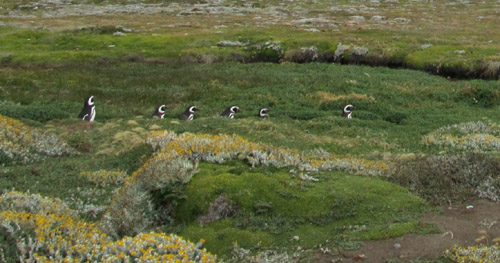
The Magellanic penguins are also called the jackass penguins because
their call sounds very much like that four-legged animal's bray.
When we got there, it was time for the adults to walk down to the
beach to feed--they do this twice a day. Their well-worn paths are
so deeply carved in the soil that only the top third of their
bodies show as they walk.
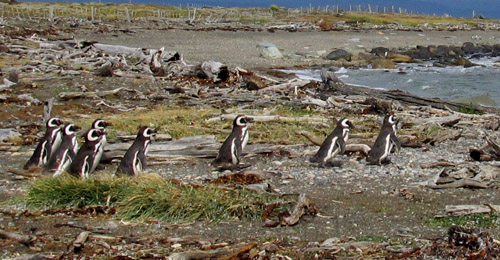


The chicks were already at the beach and were
molting--feathers flew everywhere. After they get a new set of
feathers, they'll enter the water for the first time. Right now
the chicks are as big or bigger than the adults so they have
enough body fat to take them through this phase.
|
|

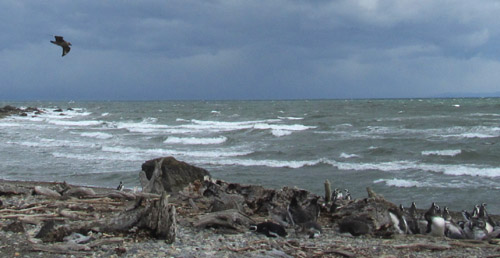
A Skua cruises over the beach looking for
weakened penguins to attack.
|
|

The weather was not pleasant--very high winds,
sleet and rain. But we were bundled up and the penguins are so darn
cute that it was definitely worth the effort. The dark glasses were
to protect our eyes from the wind not the sun.


The flag of Punta Arenas shows the yellow mountains and the Southern
Cross constellation in a blue field.
The Chilean flag is red white and blue with one large
star.
|
 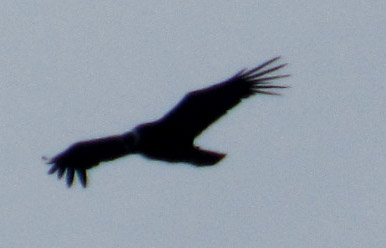
From the bus on the way back into the city we saw some Reas, ostrich-like
birds, strutting in the countryside with their feathers blown askew by the
strong winds. We also saw two huge Andean condors--very rare.
 |
As we came into town our guide (a native of Punta
Arenas, but his parents were British) told us about this building
enclosed in glass--it stays warm with only the solar radiation.
Impressive in this cold climate.
|
|


|
Our next stop was a cemetery with giant topiaries and
extravagant family mausoleums.
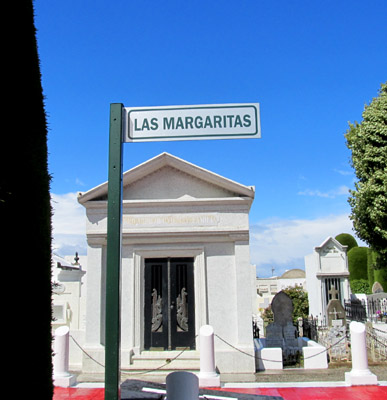 


|
|
Our last bus stop was this overlook of the city
and our ship...

We were originally scheduled to be here for one day
here, but bad weather and large waves located in our route across
the Pacific caused
the captain and the head office in Seattle to redo the itinerary
and stay here for two days before heading out. The second day was a
Sunday and many businesses were closed, but we spent some time
walking around the city.
|
|

Down at the waterfront, bunches of imperial
cormorants (blue-eyed shags) populated an old dock and its
pilings. One guy, a fellow passenger, looking at them thought they
were penguins. Their black and white feathers do give that
appearance, but when they fly, that should be a clue that they are
not penguins at all.
|
|



 

 
I spent two hours on the second floor of this
Internet cafe listening to cleverly DJ'd American rock 'n
roll. The Internet access was fairly fast and cost a
reasonable $2 per hour.
|
|
 
You may have noticed that some of our photos are
of sunny weather, but some show gray skies and wet streets. It
surprised us that the rainbows over the city seem to be as
frequent as those in Hawaii. The ride on the tenders was very
bumpy on the rough water here.
We now have our new itinerary--we'll be missing
one of our stops and will not sail through the Chilean Fjords, but
we are in for some rough seas as we head to Easter Island. As we
sailed away, the wind blowing water from the white-capped waves
created hundreds of rainbows to bid us adios.
Dean's
Log: Days 28-31
|
|




































































